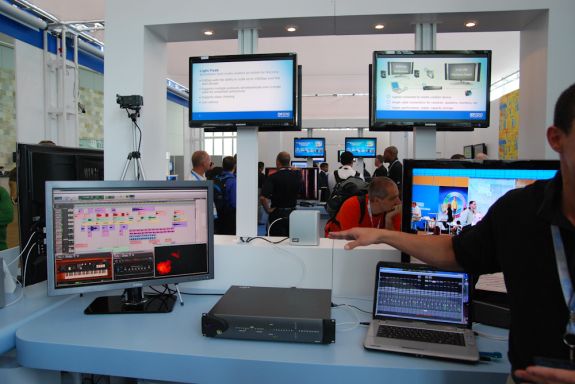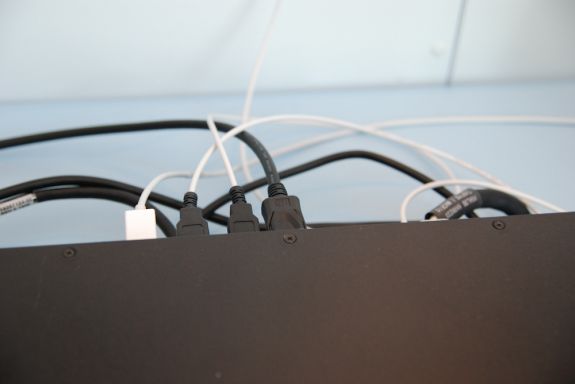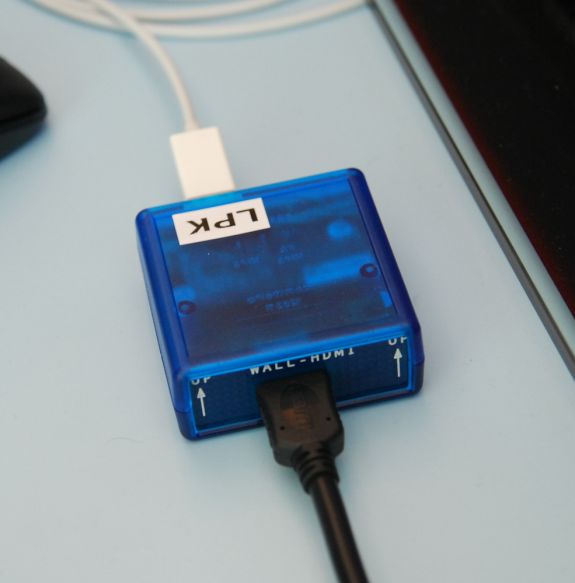Intel Light Peak - Lighting up 10 Gbps links in 2011
by Brian Klug on September 16, 2010 3:40 PM EST- Posted in
- Trade Shows
- Intel
- LightPeak
First off, Light Peak speeds remain the same as we've previously seen at 10 gigabits/s, though opportunity to scale to 100 gigabits/s remains a promise for the future. Intel had two demonstrations setup illustrating Light Peak's potential as a bus for huge amounts of traffic. First up was a Compal notebook connected to an Avid HD I/O box, which was in turn connected to two more devices. An external Western Digital dual drive solution with a Light Peak connector, and an HDMI adapter driving 1080P video content.
According to Intel, Light Peak enabled Avid to move mixing control to the Compal notebook software suite. Bandwidth is now sufficient to pass uncompressed extremely high sampling rate audio streams between the notebook and the Avid HD I/O box.
All of those white cables coming out of the Avid box on the left side are Light Peak. Note that they look a lot like USB - more on that in a moment. Light Peak connects the Avid HD I/O box and its lossless audio streams, a raw 1080P HDMI video stream, Western Digital external hard drive, and another uncompressed video played back on the Dell LCD to the left in this demo. This demo is clearly targeted at selling studio artists on Light Peak.
The Light Peak to HDMI converter box has also shrunk considerably. It's now a bit smaller in profile than a credit card:
There's no external power adapter here either, just Light Peak to HDMI for the TV. The Compal notebook has been shown around a bit before, but the connection is again seamlessly integrated into the notebook by all appearances. Check out the gallery for all the pics from this demo:



















59 Comments
View All Comments
holywarrior007 - Tuesday, September 21, 2010 - link
Probably it has nothing to do with the technology having bugs. At IDF there was a demonstration with a laptop and it worked smoothly. According to you then there are still bugs with USB 3.0 which Intel is currently fixing and could only fix until the next year? I think It has everything to do with the economics. Intel facing no competition in market is doing everything to maximize its profit and not caring about the consumers. Look at the current CPU unlocking plan. The decision to defer Lighpeak and not supporting USB 3.0 until next year has its roots in the economics and not in the technology.name99 - Thursday, September 16, 2010 - link
It is interesting that Intel has been so pigheaded about not supporting USB3 in its most recent chipsets; so one has to wonder. Is the real Intel story that they really want LightPeak to take off, they are willing to ship at cost (or lower) to make this happen, and they are desperately worried that USB3 (which is presumably intrinsically cheaper) will take up most of the volume uses for LightPeak, relegating it to expensive and limited usage for a few years at least?Likewise I have to wonder if Apple is in Intel's camp on this, which is why they, similarly, have been really pigheaded about no USB3 on any Macs.
I applaud the IDEA of the strategy, but I fear that it will fail, and that LightPeak will be FireWire all over again --- superior, sure, but with equivalent peripherals costing 20% more to no obvious benefit.
This could be solved, to at least some extent, but making sure that LightPeak carries SATA commands, rather than USB commands, to mass storage. That way external drives would get SMART, command queuing, TRIM (if they are SSDs), all the fancy SATA commands that are not passed over USB (because USB mass storage was designed by morons, and apparently has not been updated for USB3).
But I have not seen SATA in the list of protocols slated for transport over LightPeak 1.0. Anyone know anything about this? It would be truly pathetic if, in 2011 we have two high speed external bus standards, USB3 and LightPeak, BOTH of which are incapable of actually supporting a modern drive (SMART, TRIM, NCQ) in a decent fashion.
jordanclock - Friday, September 17, 2010 - link
Actually, Light Peak isn't really a USB competitor. Light Peak is protocol-agnostic. It's a physical transport layer. It's the connectors and the cable. Light Peak IS NOT related to the data or the format of the data moving across the wires. So USB, any version of it, would be just one of many protocols that operate on Light Peak. Light Peak is only a competitor of the physical interfaces, not the protocols.This would allow you to have a Light Peak connector for just about any device, from internal and external hard drives to addon cards (like video and sound cards) to networking devices or computers to connecting to displays. Light Peak is 10Gbps of cable. NOT protocol.
name99 - Friday, September 17, 2010 - link
This retarded comment system thinks my comment is spam, so I have to split it into multiple posts.(a)
LightPeak does the same thing (connect hard drives to computers in fast way) as USB3. That's the only market that matters, and as far as that goes they are competitors. The fact that you can run USB3 protocols over LP hardware is nice for OS programmers, and of no relevance to anyone else. What matters to ye average person is
- what is the extra cost of an LP equipped PC vs a USB3 equipped PC and
- what is the extra cost of an LP equipped HD vs a USB3 equipped HD.
name99 - Friday, September 17, 2010 - link
(b) The fact that LP can run SCSI or FiberChannel or whatever is of zero interest to the volume market. The fact that it can run ethernet is of marginal interest given that everyone already has a stash of ethernet cables, hubs, etc, all of which work adequately.This is why I made such a big deal about ATA over LP --- that is the one differentiating factor from USB3 that actually makes an important difference, in the one market that matters. If LP can position itself as "yes, we admit our HDs cost $20 more than USB3 HDs, but they do give you SMART, NCQ and TRIM, and that's of some value", it has a chance. If it can't even offer that, it's FW vs USB2 all over again --- another situation where FW was too damn stupid to appreciate that it should embrace native ATA commands over the physical bus rather than this stupid SCSI emulation crap. (obRant This fetishization of command sets from thirty years ago is a really stupid and embarrassing aspect of contemporary computer HW. It's stupid in the case of USB/FW mass storage, and it's stupid in the case of Bluetooth emulating modems. I'm not crazy about it in the case of ATA either, but if you're going to hitch your wagon to a has-been, at least choose a has-been of some relevance to the modern world.)
jordanclock - Friday, September 17, 2010 - link
Actually the protocol DOES matter to a consumer. Different protocols, regardless of physical transport, require licensing to use. This licensing is what determines, in part, the cost of devices and peripherals. The cost of computers with LP would probably be no different than any other bleeding edge technology at first, but come down quickly. However, the cost of devices and peripherals would be based on the licensed protocols.The fact that LP runs ANY protocol over its cable means a device manufacturer can put an LP connector on their product and use a cheap protocol, like USB. In fact, licensing is probably the reason for all the convoluted protocol issues with USB. If a manufacturer can use LP for the connector and whatever protocol is best for the task, they can custom tailor their protocol choice to whatever best fits their devices features. A dumb mass storage drive might go with USB simply because SMART, NCQ, TRIM, et. al are overkill. But if you slap a LP connector on an external SSD and use SATA as the protocol, you could have a very efficient storage device without having to open your computer or take a drive out of a hot-swap bay.
LP isn't entirely a USB competitor. It's a USB cable competitor. The USB-IF will probably still get a licensing fee and of course Intel will get a piece. Of course, manufacturers could stick with USB instead of investing in LP at all and ride the bargain train.
XZerg - Thursday, September 16, 2010 - link
How is the power being transmitted here? I realize they must have used some sort of copper cable to provide the power but there is no detail on this. Would be good to know.Brian Klug - Thursday, September 16, 2010 - link
I'm going to follow up with Intel and ask about power transport. I believe it is possible and there's a copper wire alongside the waveguide, but I'm going to check.-Brian
tdtd - Thursday, September 16, 2010 - link
A whole article on Light Peak and nothing related to Apple? Far as I had heard, Apple helped a ton with creation of this technology and is first in line to adopt into their whole product range. Check out the link below with diagrams etc -http://www.engadget.com/2009/09/26/exclusive-apple...
tlmaclennan - Thursday, September 16, 2010 - link
There may not have been any mention of Apple in the article, but it is clear that there is a picture of a MacBook Pro with the Light Peak technology.